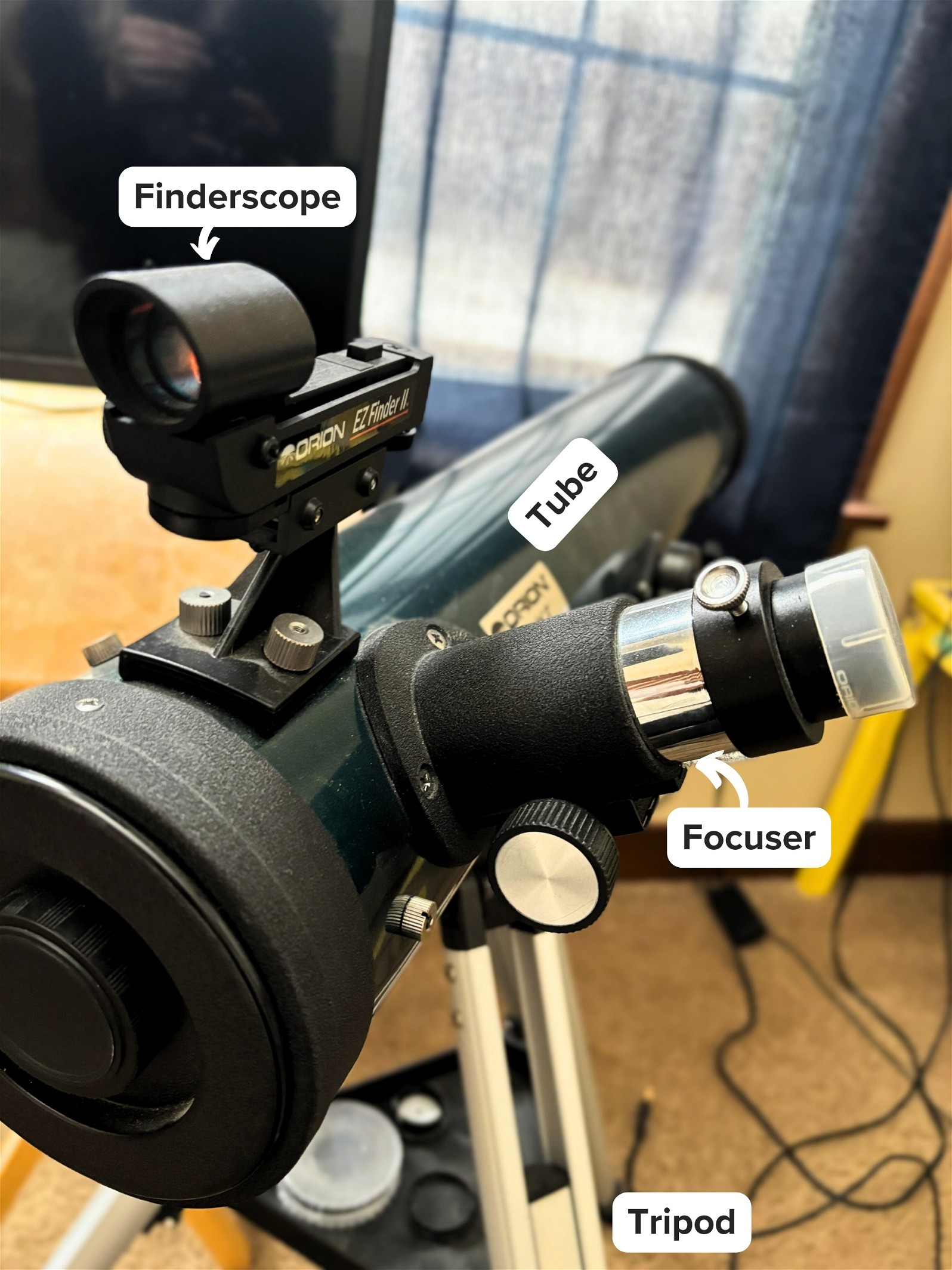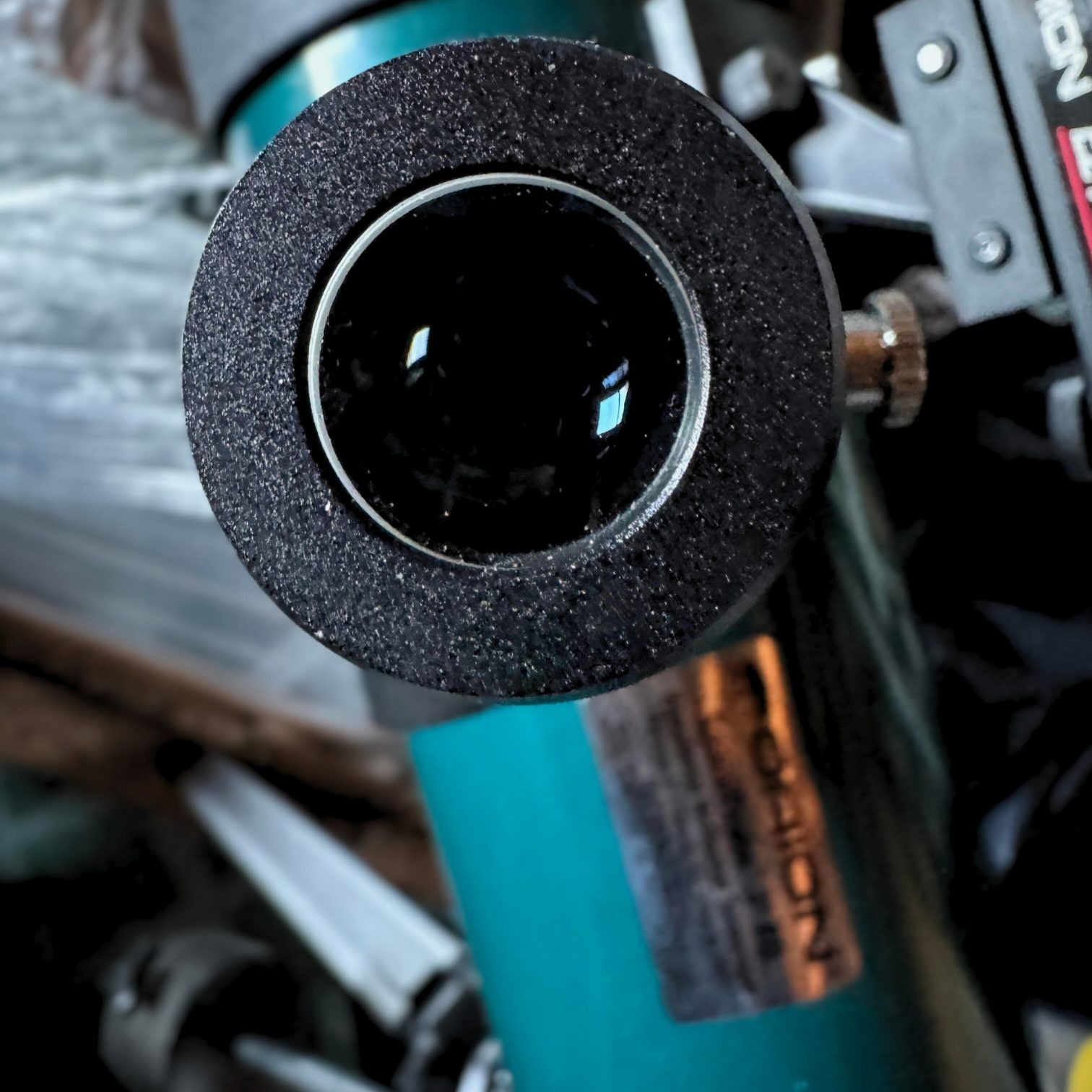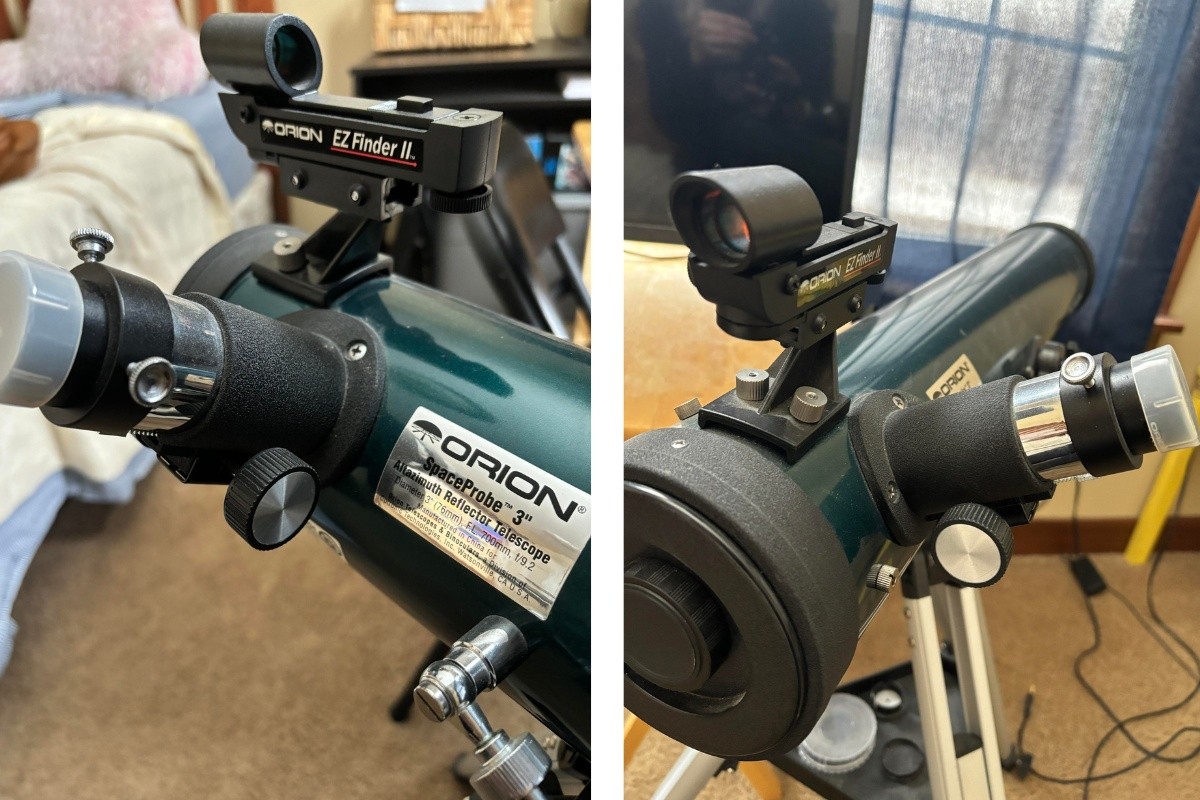The Optical Tube
The Orion SpaceProbe II 76EQ is a 76mm (3”) Newtonian reflector with a focal length of 700mm and a focal ratio of f/9.2.
The primary mirror is spherical. But at such a long focal ratio of f/9.2 and a small telescope size, I find the difference between spherical and parabolic mirrors is well within the tolerances of typical defects in a parabolic mirror.
The SpaceProbe II 76EQ provides sharp images at any magnification free of visible spherical aberration or other defects. This is not the case with 76mm f/4 tabletop reflectors, which feature severe spherical aberration.
At f/9.2, Spaceprobe II 76EQ is easy to collimate, too. The primary and secondary mirrors both require tools to collimate, but you’ll seldom, if ever, need to do this. No collimation tools are included, but a collimation cap is easy and cheap to make.

The SpaceProbe II 76EQ features a 1.25” plastic rack-and-pinion focuser to hold your eyepieces, which works just fine and is pretty standard for inexpensive beginner telescopes. The tube attaches to the provided EQ-1B mount with a plastic clamshell ring, which allows me to rotate the tube to move the eyepiece and slide it forward/backward to suitably balance the telescope on the declination axis.
Accessories
The SpaceProbe II 76EQ includes two 1.25” Kellner eyepieces: a 25mm providing 28x magnification and a 10mm providing 70x magnification.

Both of the eyepieces feature an apparent field of view of around 50 degrees and have glass optics and metal housings. The Kellner optical design works very well at f/9, with sharp views right out to the edge of the field. 70x doesn’t push the SpaceProbe II 76EQ to its limits, but it’s enough to see details on the moon and planets. On the other hand, 28x is perfect for finding and looking at many deep-sky objects.
For a finder, Orion provides a simple red dot unit for the SpaceProbe II 76EQ. This battery-powered device projects a simple dot onto a plastic viewing window, which you line up with what you want to see. It’s very easy to use, works well, and is a lot less complicated than a magnifying finder (especially low-quality and small-aperture units).
The Orion EQ-1B Equatorial Mount
The Orion SpaceProbe II 76EQ Reflector uses Orion’s EQ-1B equatorial mount, which is a version of the standard (and often infamous) generic EQ-1 equatorial mount that comes with many beginner telescopes.
The EQ-1B is an equatorial mount that must be polar aligned and balanced before use. Once I’ve done so, I just unlock the clutches on the mount to aim and use the slow-motion cables to make fine adjustments and track objects.
The benefit of an equatorial mount is that I only need to track one axis by turning a single knob, and I can easily attach a motor drive if I want to. The downsides are that it’s less steady than an alt-azimuth Dobsonian mount, requires more setup time, and can be more confusing to use as a beginner.
The EQ-1B mount works well enough and is fairly stable, though there are some vibrations when using the telescope at high magnifications, particularly with the tripod legs extended all the way. Filling the legs with sand and/or putting something heavy on the accessory tray to weigh the telescope/mount down and lower its center of gravity is indeed helpful. The EQ-1B and 76EQ OTA are so light that adding extra weight won’t significantly hamper portability.
Should I buy a used Orion SpaceProbe II 76EQ Reflector?
A used Orion SpaceProbe II 76EQ does require some inspection to make sure no parts are missing, particularly from the mount, as finding replacements is difficult and may cost more than whatever the savings are on buying used vs. new. Inspect the mirror coatings to make sure they are not corroded, too.
It’s important to keep in mind that if you are shopping on the used market, a lot of larger and more capable telescopes can be found for the same price as a new SpaceProbe II 76EQ, so you might want to opt for that instead.
Alternative Recommendations
I used to consider the Orion SpaceProbe II 76EQ as one of the cheapest telescopes that are really acceptable for adults; cheaper telescopes used to have severe compromises in their optics, accessories, or mounts that frustrated most users and made them not worth bothering with.
Under $200
- The SarBlue Mak60 with Tripod is smaller and even less capable than the SpaceProbe II 76EQ, but the telescope is much more compact and easier to set up than the SpaceProbe II 76EQ, while still providing great views of the Moon, planets, and double stars.
- However, a pair of good-quality 7×50 or 10×50 astronomy binoculars was always a viable option, too, and was equal to or beat the SpaceProbe II when it came to viewing many large deep-sky objects.
Aftermarket Accessory Recommendations
The SpaceProbe II 76EQ’s low price means it may not make a ton of sense to invest too much in more accessories. However, we have a few picks that may be worth considering.
A 15mm redline eyepiece (47x) fills the gap between your 25mm and 10mm eyepieces and provides a good medium magnification for deep-sky viewing or the Moon, while a 32mm Plossl eyepiece backs off a bit from the 25mm, providing 22x magnification and a true field of 2.3 degrees (vs. 1.75 degrees with the stock eyepiece). A 6mm goldline or redline eyepiece will give you a magnification of 117x, which is about as high as a 3″ telescope like the SpaceProbe II 76EQ can realistically go. This magnification is perfect for looking at planets or splitting close double stars.
The EQ-1B mount of the SpaceProbe II 76EQ can also be motorized for automatic tracking. The Celestron Logic Drive attaches in just a few minutes and will enable you to observe the Moon, planets, and double stars at high power without fiddling with the slow-motion cables, as well as allow for basic astrophotography of the Moon and planets with your smartphone and an adapter or a dedicated astronomy camera.
What can you see with Orion SpaceProbe II 76EQ?
The SpaceProbe II 76EQ’s small aperture limits it primarily to bright targets such as the Moon and planets, as well as double stars and some of the brightest deep-sky objects. You’ll be able to see the phases of Mercury and Venus, and tons of detail on the Moon. Mars’ polar ice cap is also visible, and when Mars is close to Earth, you may be able to resolve a couple of dark markings at high magnification under steady seeing conditions.
The four largest moons of Jupiter are easy to see with the SpaceProbe II 76EQ, and at high magnification, their disks are just barely visible when they transit in front of the planet, alongside their shadows (which are usually much easier to see than the moons themselves, thanks to their higher contrast). Jupiter dazzles with its colorful cloud belts, and the Great Red Spot can just barely be resolved amidst them.
Saturn’s rings look tack sharp at high power through the SpaceProbe II 76EQ, and the Cassini Division within them can be resolved on a good night, along with cloud belts and the moons Titan and Rhea. The fainter moons Tethys, Dione, and Iapetus can also be seen with a 3” telescope like the 76EQ and a careful eye. Uranus’ teal disk can just barely be resolved, while deep-blue Neptune will remain a fuzzy “star” at best with the small aperture and limited resolving power of the SpaceProbe II 76EQ. Its meager 3” of aperture is far too small to reveal the faint moons of either ice giant, nor is it sufficient to see distant and tiny Pluto.
The SpaceProbe II 76EQ does a decent job on bright deep-sky objects. Open star clusters like the Double Cluster, M35, M11, or the Pleiades (M45) show colorful, pinpoint stars, while globular star clusters like M13 or M15 remain fuzzy balls, their individual stars just a bit too dim and beyond the resolving power of the SpaceProbe II 76EQ.
Almost all of the planetary nebulae in the night sky are too small and dim to see, let alone recognize, with only a 3” telescope, but the Ring Nebula (M57) can be identified, and the apple-core shape of the Dumbbell (M27) is visible provided your light pollution conditions aren’t too extreme. You can also see the gas clouds of the Orion Nebula (M42) and the Lagoon (M8), along with the embedded open star clusters within each, and a few others like the Swan (M17) and Trifid (M20) are visible, albeit faintly. Light-polluted skies will make viewing nebulae and galaxies more difficult with any telescope, though not impossible. Most galaxies are invisible, or faint smudges at best, with the SpaceProbe II 76EQ, though the Virgo Cluster shows at least a dozen members, and you might be able to see the dust lanes of M31 and M82, along with their associated companion galaxies, under dark skies. Many thousands of colorful double stars can also be viewed and resolved with the Orion SpaceProbe II 76EQ, regardless of your light pollution conditions.



